We’ve all felt that instant warmth when stepping into a beautiful farmhouse kitchen – there’s something magical about these spaces that perfectly blend rustic charm with modern functionality. The farmhouse aesthetic has captured our hearts and homes with its emphasis on natural materials, vintage-inspired elements, and cozy gathering spaces that invite family and friends to linger.
The popularity of farmhouse kitchens isn’t just a passing trend – it’s a design philosophy that celebrates simplicity, comfort, and timeless appeal. From shiplap walls and apron-front sinks to open shelving and distressed wood finishes, these kitchens create an atmosphere that feels both elegant and effortlessly lived-in.
Whether you’re planning a complete kitchen renovation or looking to incorporate farmhouse touches into your existing space, we’ll guide you through the essential elements that make these kitchens so irresistibly appealing. Get ready to transform your kitchen into a stunning farmhouse haven that combines style with everyday practicality.
Embrace Rustic Wood Elements in Your Farmhouse Kitchen Design
Wood elements form the foundation of authentic farmhouse kitchen design, bringing warmth and character that manufactured materials simply can’t replicate.
Reclaimed Wood Countertops for Authentic Character
Reclaimed wood countertops instantly transform your kitchen with their weathered patina and unique grain patterns. We love how these surfaces tell stories through their imperfections—nail holes, saw marks, and natural color variations that add genuine character to your space.
Installing reclaimed wood countertops requires proper sealing to protect against moisture and daily kitchen use. Food-safe finishes like tung oil or specialized wood sealers ensure your countertops remain both beautiful and functional for years to come.
Butcher block styles work exceptionally well in farmhouse kitchens, offering a practical surface for food preparation while maintaining that rustic appeal. Pair these countertops with white farmhouse sinks or vintage-style faucets to create a cohesive design that feels both timeless and purposeful.
Exposed Ceiling Beams for Structural Beauty
Exposed ceiling beams create dramatic vertical interest while emphasizing the architectural bones of your farmhouse kitchen. These structural elements draw the eye upward, making even modest kitchens feel more spacious and grand.
Original beams showcase the most authentic farmhouse character, but reclaimed timber offers an excellent alternative for homes without existing structural elements. We recommend using beams that match your kitchen’s scale—larger kitchens can handle substantial 8×8 inch beams, while smaller spaces benefit from more modest 4×6 inch dimensions.
Staining beams in rich walnut or leaving them natural creates striking contrast against white or cream painted ceilings. Consider adding pendant lights suspended from the beams to combine functionality with your farmhouse aesthetic.
Barn Wood Accent Walls for Textural Interest
Barn wood accent walls provide instant farmhouse charm while adding rich texture and visual depth to your kitchen. We suggest focusing on one statement wall—typically behind the range or sink area—to create a stunning focal point without overwhelming the space.
Authentic barn wood brings natural color variations from gray weathered planks to warm honey tones that complement both light and dark kitchen palettes. Installing these planks horizontally creates a traditional shiplap effect, while vertical installation adds height and modern farmhouse flair.
Mixing barn wood with other materials like subway tile or natural stone creates layered textures that define sophisticated farmhouse design. Balance the rustic wood with clean lines and modern appliances to achieve that perfect blend of old industry charm and contemporary function.
Install Classic Farmhouse Sinks for Functional Style

Farmhouse sinks serve as both statement pieces and practical workhorses in your kitchen design. These distinctive fixtures bridge the gap between rustic charm and modern functionality.
Apron-Front Sink Designs and Materials
Stainless steel farmhouse sinks deliver exceptional durability while maintaining a clean, professional appearance. Professional kitchens often favor this material because it resists stains, scratches, and heat damage. We recommend choosing 16-gauge stainless steel for optimal strength and longevity.
Cast iron sinks provide timeless elegance with their smooth, porcelain-coated surfaces. These heavyweight options come in various colors including classic white, cream, and even bold blues or greens. Maintenance requires gentle cleaners to preserve the enamel coating.
Fireclay sinks offer superior scratch and chip resistance compared to other ceramic materials. Manufacturing involves firing clay at extremely high temperatures, creating a dense, non-porous surface. White fireclay sinks particularly complement traditional farmhouse aesthetics.
Apron front panels create the signature farmhouse look by extending beyond the cabinet face. Single bowl designs maximize workspace for large pots and baking sheets. Double bowl configurations provide separate areas for washing and food preparation.
Proper Installation Considerations
Cabinet modifications require professional assessment to ensure structural integrity. Standard base cabinets need reinforcement to support the additional weight of farmhouse sinks. We suggest consulting a contractor before purchasing your sink.
Countertop adjustments become necessary when transitioning from undermount to apron front installations. Granite and marble countertops require precise cutting to accommodate the sink’s front panel. Proper measurements prevent costly mistakes during installation.
Plumbing relocations may be needed depending on your current setup. Drain placement differs from standard sinks, potentially requiring new pipe configurations. Professional plumbers ensure proper connections and prevent future leaks.
Weight distribution demands adequate support beneath the sink basin. Reinforcement brackets or additional framing distribute the load across multiple cabinet components. Heavy materials like cast iron require maximum support structures.
Complementary Faucet Styles
Wall mounted faucets create dramatic visual impact while maximizing counter space around your farmhouse sink. These installations require proper wall reinforcement and careful planning for plumbing lines. Commercial style wall mounts particularly enhance the professional kitchen aesthetic.
Single handle designs offer practical operation with one hand while maintaining period appropriate styling. Bridge faucets connect hot and cold water supplies above the sink deck. We prefer brass or bronze finishes to complement traditional farmhouse materials.
Vintage inspired faucets feature cross handles and exposed pipes for authentic farmhouse charm. Gooseneck spouts provide ample clearance for filling large pots and cleaning oversized items. Pull down sprayers add modern convenience without compromising the classic aesthetic.
Finish coordination ties your faucet selection to other kitchen hardware and fixtures. Oil rubbed bronze creates warmth against white or cream colored sinks. Brushed nickel offers versatility with both traditional and contemporary farmhouse designs.
Choose Vintage-Inspired Color Palettes That Define Farmhouse Charm
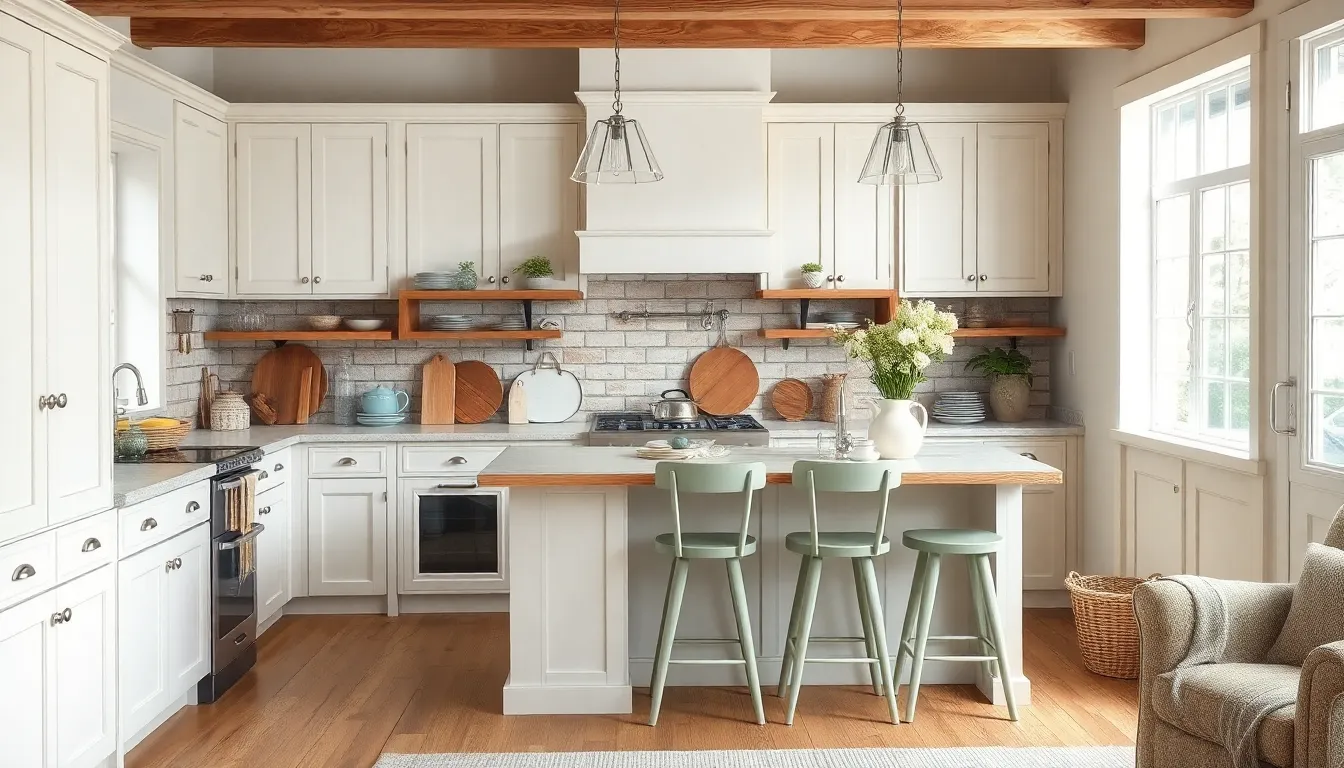
Color choices establish the foundation of any successful farmhouse kitchen design. These carefully curated palettes create the perfect backdrop for showcasing rustic elements and vintage-inspired features.
Crisp White and Cream Combinations
White cabinets paired with cream accents create the quintessential farmhouse kitchen atmosphere. This classic palette offers a clean and airy feel that makes even compact kitchens appear more spacious. We recommend using warm white tones rather than stark bright whites to maintain the cozy farmhouse aesthetic.
Cream-colored walls complement white cabinetry beautifully while adding subtle warmth. Natural wood accents like reclaimed countertops or exposed beams pop against this neutral backdrop. Vintage decor pieces such as mason jar storage containers or antique cutting boards enhance the authentic farmhouse charm.
Layering different shades within the white and cream family prevents the space from feeling flat. Consider incorporating off-white subway tiles for backsplashes or choosing cabinet hardware in brushed cream finishes. These subtle variations add depth without disrupting the cohesive color story.
Sage Green and Muted Blue Accents
Sage green cabinetry brings earthy sophistication to farmhouse kitchens. This versatile color works exceptionally well with white countertops and brass hardware for a refined country look. We’ve seen sage green lower cabinets paired with white upper cabinets create stunning two-tone designs.
Muted blue accents add unexpected charm through strategic placement on kitchen islands or accent walls. These earthy tones complement traditional farmhouse elements like wooden beams and stone fireplaces perfectly. Dusty blue bar stools or vintage-inspired dishware displayed on open shelving reinforce this color palette.
Both colors create a sense of warmth and coziness that defines authentic farmhouse style. Consider using these hues for painted furniture pieces like hutches or dining tables to tie the entire kitchen together. Natural materials like butcher block countertops enhance the organic feel of these nature-inspired colors.
Warm Neutral Tones for Timeless Appeal
Beige and taupe provide versatile backdrops for mixing vintage and modern elements seamlessly. These timeless colors allow statement pieces like farmhouse sinks or vintage lighting fixtures to take center stage. Warm neutrals work particularly well in kitchens with abundant natural light.
Greige tones offer sophisticated alternatives to traditional beiges while maintaining farmhouse warmth. This gray-beige hybrid complements both cool and warm accent colors, making it easier to incorporate seasonal decor changes. We recommend testing paint samples in different lighting conditions before committing to these subtle hues.
Layering various neutral tones creates visual interest without overwhelming the space. Combine warm neutral wall colors with natural wood elements and textured fabrics like linen window treatments. These combinations establish the perfect foundation for building a farmhouse kitchen that feels both current and timeless.
Incorporate Shiplap Walls for Authentic Farmhouse Character
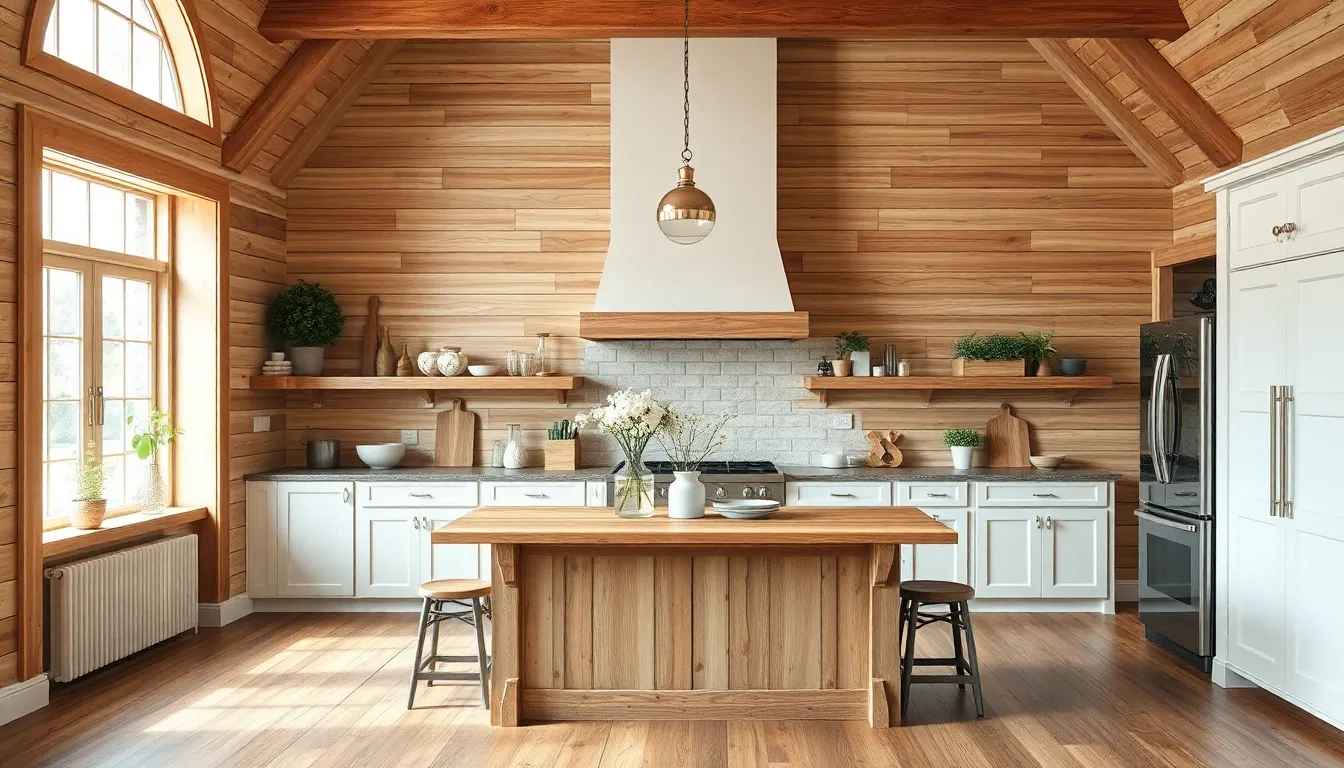
Shiplap walls serve as one of the most defining features in farmhouse kitchen design, instantly transforming any space with their rustic authenticity. We’ll explore the installation methods and finish options that deliver the most impactful farmhouse character.
Horizontal Shiplap Installation Techniques
Horizontal shiplap installation creates the traditional farmhouse aesthetic we associate with classic country kitchens. Each board overlaps slightly with the next, forming a seamless appearance that emphasizes the room’s width while adding immediate warmth to the space.
Installing shiplap horizontally requires careful attention to board alignment and consistent spacing. We recommend starting from the bottom and working upward, ensuring each row remains perfectly level throughout the installation process. This technique works particularly well on accent walls behind ranges or dining areas, where the horizontal lines draw the eye across the room’s focal points.
Vertical Shiplap for Height Enhancement
Vertical shiplap offers a modern twist on the traditional farmhouse look while creating the illusion of dramatically higher ceilings. This installation method draws the eye upward, making kitchens with standard ceiling heights feel more spacious and airy.
We’ve found that vertical shiplap works exceptionally well in galley kitchens or narrow spaces where height enhancement becomes crucial for visual balance. The vertical lines add depth and visual interest while maintaining the authentic farmhouse character homeowners desire. Consider using this technique on kitchen islands or peninsula walls where the height effect can maximize the room’s architectural impact.
Painted vs. Natural Wood Finishes
Painted shiplap delivers a bright, clean aesthetic that enhances the airy feel characteristic of modern farmhouse kitchens. White and pastel colors remain the most popular choices, creating a classic backdrop that complements both vintage and contemporary elements seamlessly.
Natural wood finishes emphasize the rustic charm inherent in shiplap’s texture and grain patterns. We recommend light staining techniques that preserve the wood’s natural character while adding warmth and authentic texture to the kitchen environment. These finishes work particularly well when paired with other natural materials like reclaimed wood countertops or exposed ceiling beams.
Choosing between painted and natural finishes depends on your kitchen’s overall color palette and desired level of rustic character. Painted options integrate easily with bright, clean farmhouse designs, while natural wood finishes complement kitchens featuring multiple organic textures and earth toned elements.
Select Open Shelving Solutions for Display and Storage
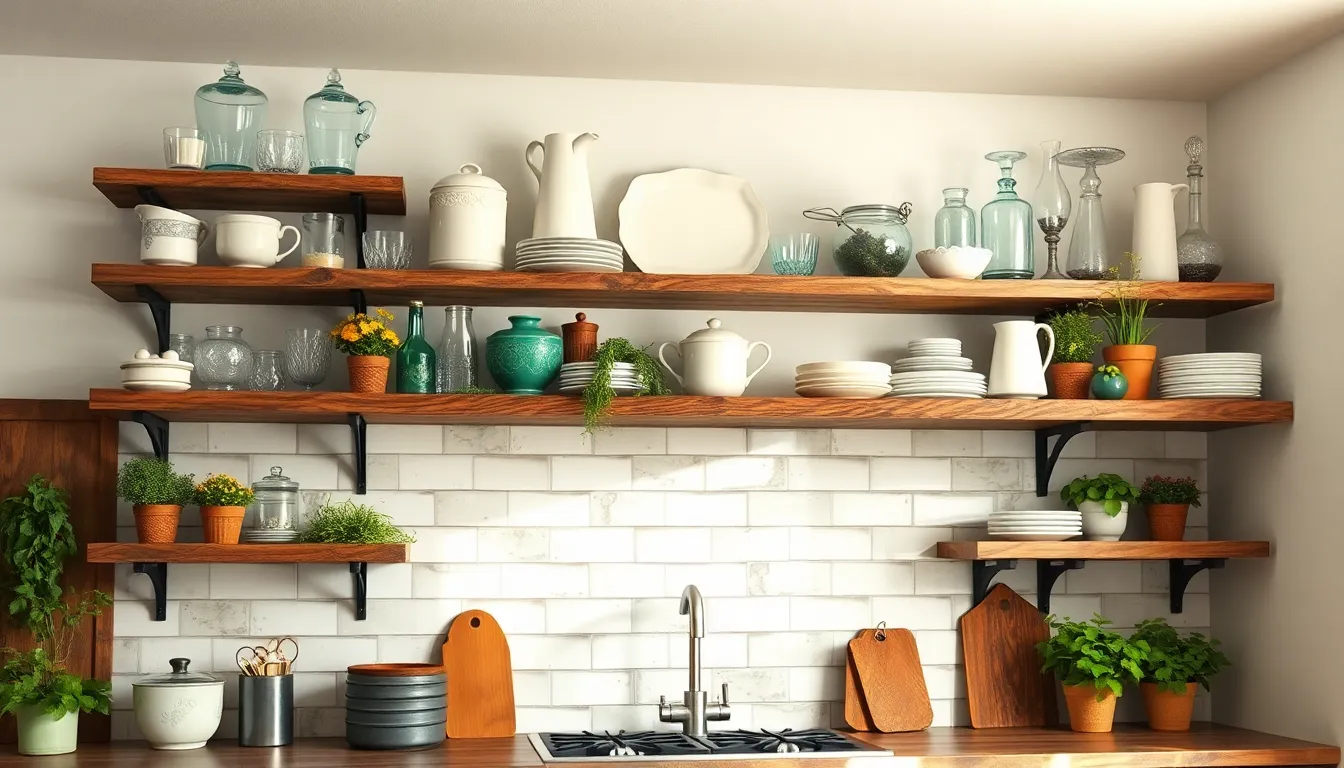
Open shelving transforms farmhouse kitchens into functional showcases that blend practical storage with decorative appeal. We’ll explore smart shelving options that enhance your kitchen’s rustic charm while keeping essentials within easy reach.
Floating Shelves with Rustic Brackets
Floating shelves paired with rustic brackets create the perfect balance between modern functionality and vintage farmhouse aesthetics. These brackets, crafted from wrought iron or weathered wood, add visual interest while supporting your kitchen essentials with style.
Metal brackets work exceptionally well with reclaimed wood shelves, creating an industrial farmhouse fusion that feels both current and timeless. We recommend positioning these shelves at eye level to showcase your favorite dishes, vintage glassware, or ceramic collections.
Wooden brackets complement lighter wood tones and painted cabinetry beautifully. Choose brackets with decorative corbel details to enhance the traditional farmhouse appeal, ensuring they’re sturdy enough to hold heavier items like cast iron cookware or large serving platters.
Built-In Shelving with Farmhouse Details
Built-in shelving maximizes storage potential while incorporating authentic farmhouse architectural elements. These custom answers blend seamlessly with your kitchen’s existing cabinetry and provide substantial display space for both functional and decorative items.
Wooden trim details elevate basic built-in shelves into farmhouse focal points. We suggest adding beadboard backing, fluted pilasters, or simple crown molding to create depth and visual texture that complements your kitchen’s overall design scheme.
Corbels underneath shelves add structural support while introducing classic farmhouse charm. These decorative brackets, whether carved wood or simple wooden supports, create the illusion of traditional craftsmanship and help distribute weight evenly across longer shelf spans.
Styling Tips for Functional Displays
Layered displays create visual depth by combining everyday kitchen essentials with decorative elements. We recommend mixing vintage cookware, ceramic pitchers, and cookbooks with frequently used items to achieve a lived-in, authentic farmhouse feel.
Grouping similar items together establishes visual cohesion while maintaining functional accessibility. Cluster vintage mason jars, arrange wooden cutting boards by size, or display matching dinnerware sets to create pleasing compositions that serve both aesthetic and practical purposes.
Adding fresh greenery breathes life into your shelving displays and softens the rustic elements. Small potted herbs like basil or rosemary provide cooking convenience while trailing plants like pothos add natural movement and color to your farmhouse kitchen shelving.
Add Vintage Lighting Fixtures for Ambiance and Function

Transform your farmhouse kitchen with carefully selected vintage lighting that enhances both functionality and aesthetic appeal. These timeless fixtures create warm, inviting atmospheres while providing practical illumination for cooking and dining tasks.
Industrial Pendant Lights Over Islands
Industrial pendant lights deliver exceptional functionality while maintaining the sleek, modern appeal that perfectly complements farmhouse decor. We recommend positioning these fixtures 30-36 inches above your kitchen island to provide ample lighting for food preparation and casual dining. Metal finishes like oil-rubbed bronze or aged brass work particularly well, offering durability alongside vintage charm.
Consider grouping two or three pendant lights over larger islands to ensure even light distribution. Single oversized pendants work beautifully over compact kitchen islands, creating dramatic focal points that anchor the space. These fixtures often feature exposed bulbs or wire cage designs that emphasize their industrial heritage while maintaining the clean lines essential to modern farmhouse aesthetics.
Mason Jar and Galvanized Metal Fixtures
Mason jar fixtures and galvanized metal elements represent quintessential farmhouse lighting that adds authentic rustic touches to any kitchen space. We’ve found these materials work exceptionally well as pendant lights over breakfast bars or as decorative accent pieces throughout the room. Their weathered finishes and vintage silhouettes instantly evoke the charm of traditional farmhouse living.
Transform individual mason jars into pendant lights by adding simple cord kits and vintage-style Edison bulbs. Galvanized metal sconces flanking windows or doorways provide ambient lighting while reinforcing the farmhouse theme. These fixtures typically feature distressed finishes that complement wood cabinetry and natural stone surfaces perfectly.
Group varying sizes of mason jar pendants at different heights to create visual interest and layered lighting effects. Galvanized metal barn-style fixtures work particularly well in mudroom transitions and breakfast nook areas, extending the farmhouse aesthetic throughout connected spaces.
Wrought Iron Chandeliers for Dining Areas
Wrought iron chandeliers offer classic farmhouse charm that transforms dining spaces into warm, inviting gathering places. We suggest selecting fixtures with candle-style bulbs or exposed Edison bulbs to create the authentic ambiance these pieces are known for. Their substantial presence works beautifully in dining areas with higher ceilings, providing both adequate illumination and dramatic visual impact.
Choose chandeliers with hand-forged details and distressed black or bronze finishes that complement your existing hardware and fixtures. Multi-tiered designs add vertical interest while maintaining the rustic elegance essential to farmhouse dining spaces. These fixtures typically feature scrollwork and decorative elements that cast beautiful shadow patterns on walls and ceilings.
Position your wrought iron chandelier approximately 30-32 inches above your dining table surface for optimal lighting and visual proportion. Dimmer switches allow you to adjust brightness levels for different occasions, from bright family meals to intimate dinner parties that showcase the fixture’s warm, romantic glow.
Design Custom Cabinetry with Farmhouse Details
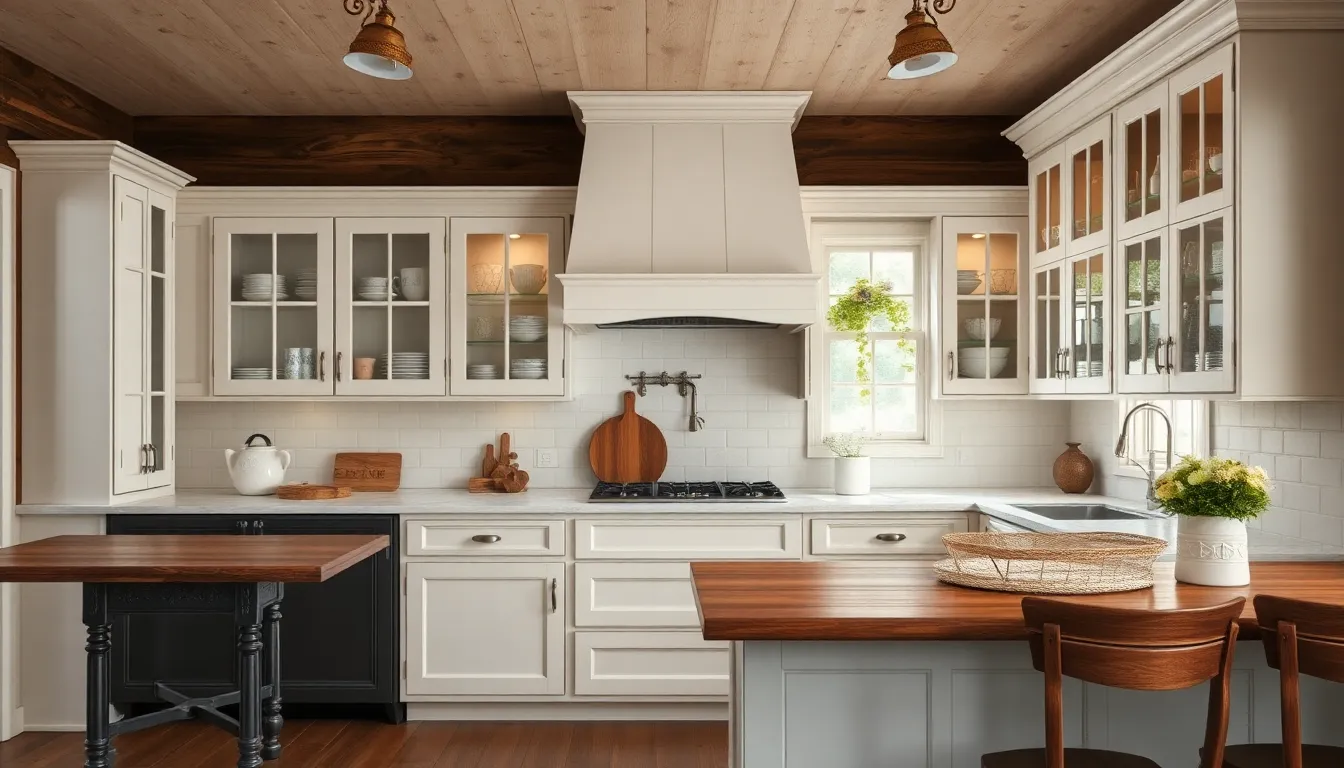
Custom cabinetry forms the foundation of any authentic farmhouse kitchen design. We’ll explore three essential elements that transform standard cabinets into farmhouse masterpieces.
Shaker-Style Door Profiles
Shaker style cabinets represent the quintessential farmhouse kitchen aesthetic with their clean, timeless appeal. We love how these simple square frames paired with flat center panels create understated elegance that works beautifully in any farmhouse setting. The versatility of Shaker profiles allows us to choose between painted finishes for a crisp, modern farmhouse look or natural wood tones for a more traditional rustic appearance.
Square frames eliminate unnecessary ornamentation while maintaining visual interest through their proportional design. Flat center panels provide a perfect canvas for showcasing various finishes and colors that complement your overall farmhouse theme. We recommend selecting Shaker cabinets as your primary style choice because they seamlessly blend classic farmhouse charm with contemporary functionality.
Distressed Paint Finishes and Hardware
Distressed paint finishes add authentic character and historical depth to farmhouse cabinetry that new finishes simply can’t replicate. We achieve this weathered look through careful sanding and layering techniques that create the appearance of natural aging over time. The level of distressing can range from subtle wear around edges to more pronounced weathering for a truly vintage appearance.
Vintage inspired hardware transforms basic cabinets into farmhouse focal points when we pair cup handles with distressed finishes. Antique brass knobs complement the aged paint beautifully while providing functional elegance for daily use. We suggest choosing hardware that feels substantial in your hand since quality pieces enhance both the aesthetic appeal and durability of your farmhouse cabinetry.
Glass-Front Cabinets for Display
Glass front upper cabinets create opportunities to showcase our favorite dishware, collectibles, and glassware while maintaining an open, airy kitchen atmosphere. We position these display cabinets strategically to highlight beautiful pieces that contribute to the curated, collected farmhouse look. The transparency of glass doors prevents the kitchen from feeling closed off while providing dust protection for displayed items.
Display opportunities multiply when we combine glass front cabinets with open shelving throughout the kitchen design. Curated collections of vintage dishes, mason jars, and farmhouse accessories create visual interest that draws the eye upward. We recommend organizing displayed items by color, size, or theme to maintain the cohesive farmhouse aesthetic while showcasing your personal style and treasured pieces.
Integrate Antique and Repurposed Furniture Pieces
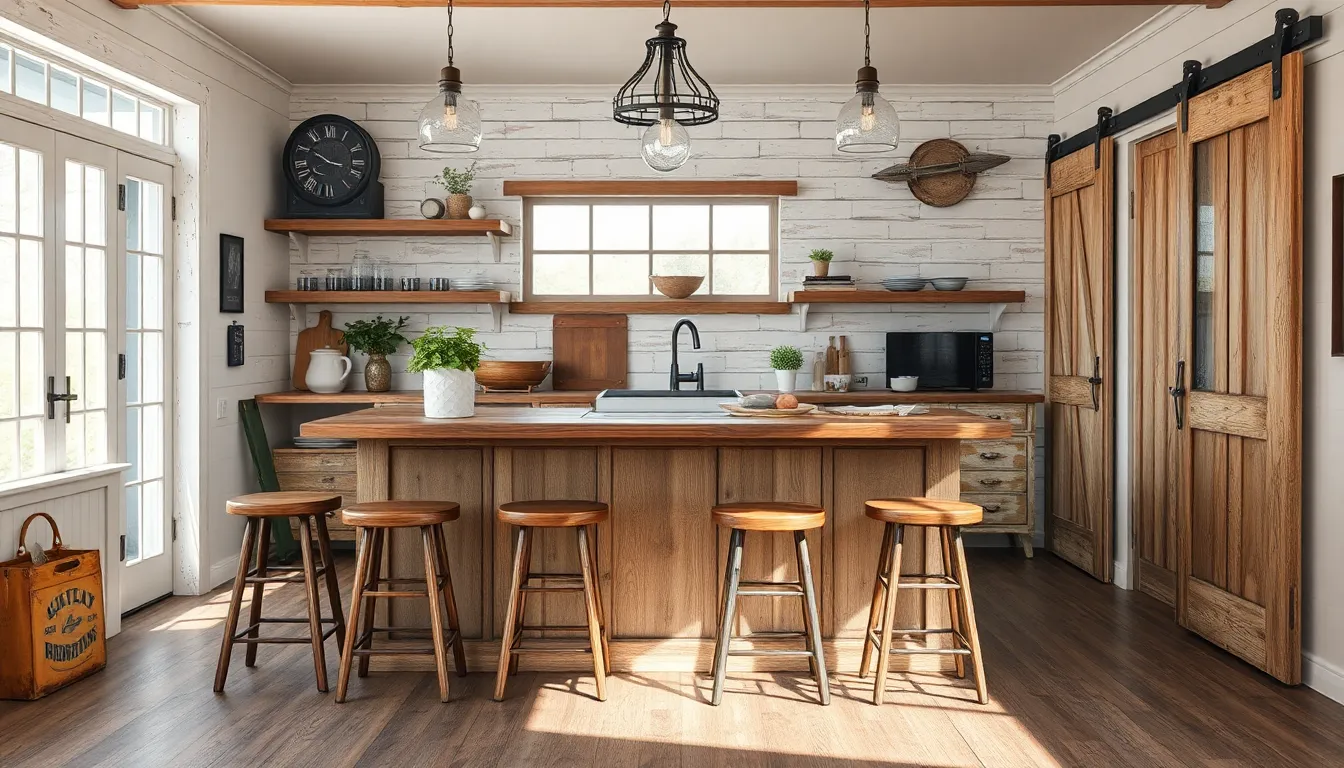
We’re transforming farmhouse kitchens by incorporating character-rich antique and repurposed furniture pieces that create unfitted kitchen designs with authentic rustic appeal. Freestanding furniture like antique cupboards replaces traditional built-in cabinetry, delivering the timeless charm that defines true farmhouse aesthetics.
Vintage Kitchen Islands and Carts
Antique kitchen islands serve as functional centerpieces that provide extra storage while adding distinctive character to your farmhouse kitchen. We recommend sourcing vintage pieces with original patina and weathered finishes that tell their own stories. Rustic wooden carts with distressed surfaces create cozy atmospheres and can be moved throughout the space as needed.
Rolling vintage carts work beautifully as mobile prep stations or coffee bars. Metal and wood combinations offer durability while maintaining that sought-after farmhouse aesthetic. Original hardware like cast iron wheels and wrought iron handles enhance the authentic vintage appeal we’re cultivating.
Repurposed Barn Doors as Pantry Doors
Old barn doors introduce immediate rustic charm when repurposed as pantry entrances in farmhouse kitchens. We love how these weathered wood pieces bring outdoor elements inside while serving practical storage purposes. Sliding barn door hardware creates space-saving answers perfect for smaller farmhouse kitchen layouts.
Original paint chips and nail holes add authentic character that new materials simply can’t replicate. Horizontal planking typical of barn doors creates visual width in narrow pantry openings. Installing these repurposed pieces requires proper reinforcement to handle the weight of solid wood construction.
Antique Stools and Seating Options
Vintage stools made from materials like reclaimed wood or aged metal complement farmhouse kitchen islands perfectly. We suggest mixing different heights and styles to create collected-over-time appeal rather than matched sets. Antique milking stools and farm stools bring authentic agricultural history into modern farmhouse spaces.
Distressed wooden benches provide cozy seating areas that accommodate multiple family members during meal preparation. Cast iron bases paired with weathered wood tops offer durability while maintaining vintage charm. Original paint finishes on antique seating pieces create focal points that anchor the entire farmhouse kitchen design.
Metal shop stools with adjustable heights work wonderfully at kitchen islands of varying counter levels. We display vintage kitchenware on open shelves or hang them from rods to further enhance the rustic atmosphere these antique pieces help establish.
Create Cozy Breakfast Nooks with Farmhouse Appeal
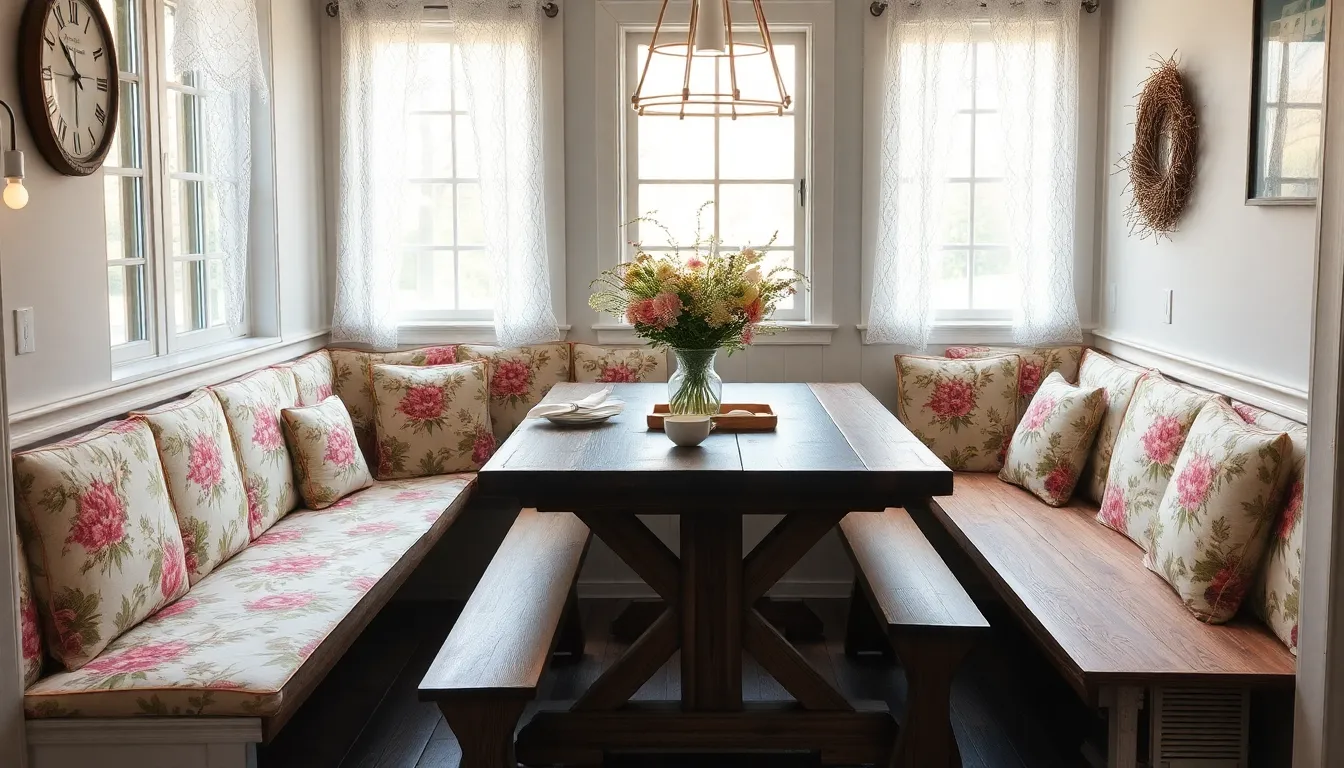
A well-designed breakfast nook becomes the heart of your farmhouse kitchen where family gathers for morning coffee and intimate meals. These cozy corners blend functionality with rustic charm, creating spaces that invite lingering conversations and peaceful moments.
Built-In Banquette Seating Ideas
Custom storage answers transform built-in banquettes into multifunctional spaces that maximize your kitchen’s efficiency. We recommend incorporating hidden storage compartments beneath the seating for linens, cookbooks, and essential kitchen items that need organized homes.
Upholstery choices define the character of your banquette seating with vintage-inspired patterns like florals and stripes adding authentic farmhouse appeal. Natural materials such as wood frames and wicker accents blend seamlessly with your existing rustic elements while providing comfortable gathering spots.
Design flexibility allows you to customize banquette dimensions to fit your exact space requirements and seating needs. Corner configurations work particularly well in smaller kitchens, while L-shaped designs accommodate larger families and frequent entertaining.
Rustic Dining Tables and Benches
Reclaimed wood materials create authentic farmhouse dining surfaces that showcase natural character through weathered grains and distressed finishes. These sustainable options bring environmental consciousness to your design while delivering the rustic aesthetic you’re seeking.
Vintage hardware details enhance the rustic appeal of your dining furniture with metal brackets and wooden accents that echo traditional craftsmanship. Matching bench designs provide cohesive seating answers that complement your farmhouse table’s proportions and style.
Comfort enhancements include throw pillows and cushions featuring rustic patterns that invite extended meal times and conversations. Fabric choices in natural textures like linen and cotton maintain your farmhouse theme while providing practical seating comfort.
Window Treatments for Natural Light
Sheer curtain options maximize natural light penetration while maintaining the vintage aesthetic that defines farmhouse style. Lace panels add delicate texture and visual interest without blocking the sunshine that makes breakfast nooks feel warm and inviting.
Wooden shutters provide versatile light control options that complement your rustic design elements while offering privacy when needed. These architectural features serve dual purposes as both functional window treatments and decorative farmhouse accents.
Natural fabric selections in linen and cotton maintain your authentic farmhouse atmosphere while filtering harsh sunlight into gentle illumination. Drape styles can range from simple panels to gathered treatments that add softness to your breakfast nook’s overall design scheme.
Add Decorative Accessories That Complete the Farmhouse Look
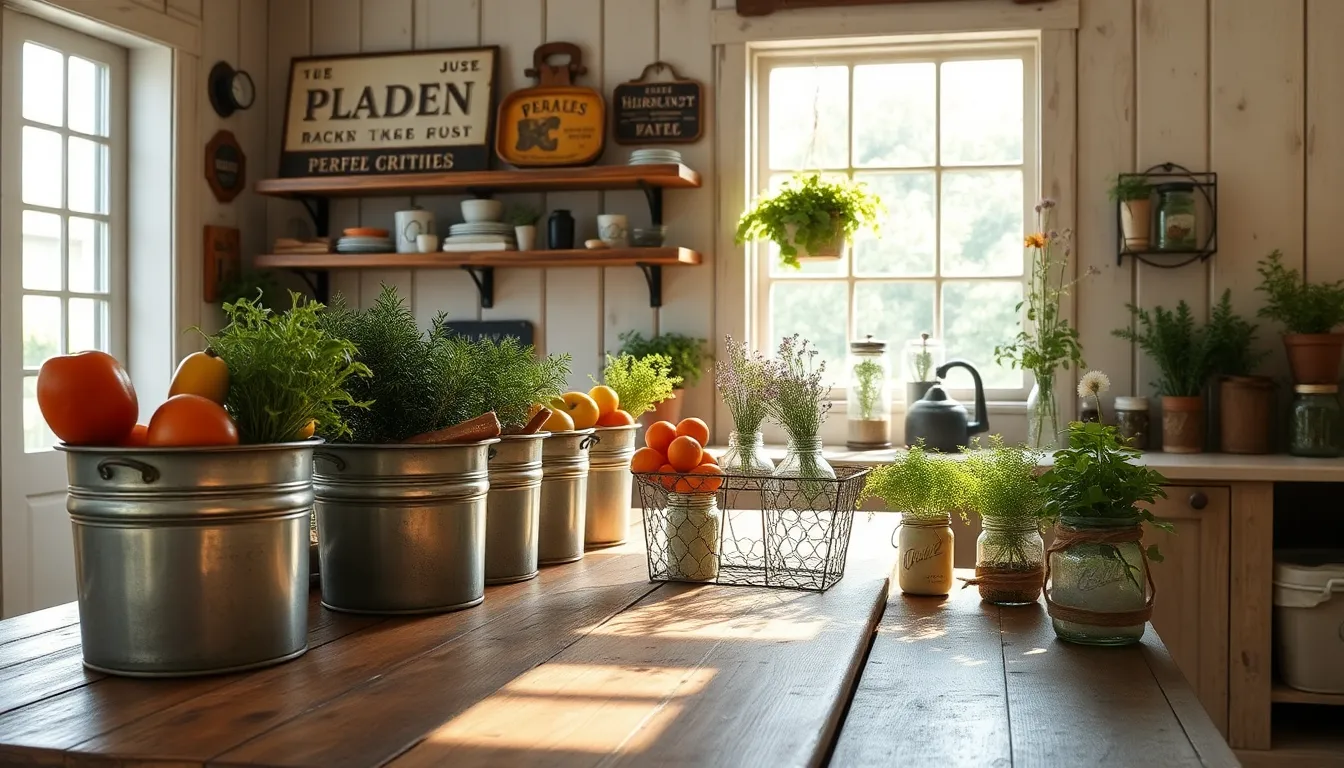
The perfect farmhouse kitchen extends beyond structural elements to include carefully chosen decorative accessories that bring warmth and personality to your space. These finishing touches transform a good design into an authentic farmhouse experience that feels lived in and loved.
Galvanized Metal Accents and Containers
Galvanized metal introduces industrial charm while maintaining the rustic authenticity your farmhouse kitchen deserves. We recommend incorporating these durable materials through pendant lights that cast warm ambient lighting over kitchen islands or dining areas. Metal containers serve dual purposes as both storage answers and decorative elements throughout your space.
Storage becomes stylish when you display fresh produce in galvanized buckets or organize kitchen utensils in matching metal containers. These practical accessories complement your existing farmhouse features while adding textural contrast against wooden surfaces. Consider grouping containers of varying sizes to create visual interest on open shelving or countertops.
Vintage Signage and Wall Art
Wall art breathes character into farmhouse kitchens through carefully selected vintage pieces that tell your family’s story. Distressed wood plaques featuring farm inspired sayings or family mottos create focal points that guests naturally gravitate toward during gatherings. Antique maps of your local area or agricultural regions add geographical context while maintaining the rustic aesthetic.
Vintage signs work particularly well when hung above breakfast nooks or positioned near entryways where they welcome visitors into your space. We suggest mixing different sizes and textures to avoid a uniform appearance that feels too planned. These conversation starters often become the most memorable elements of your kitchen design.
Fresh Flowers and Greenery Displays
Natural elements soften the harder edges of farmhouse design while bringing life and color into your kitchen environment. Wildflowers arranged in mason jars or vintage pitchers add seasonal beauty that changes throughout the year. Potted herbs serve double duty by providing fresh ingredients for cooking while contributing to your decorative scheme.
Eucalyptus branches or ferns displayed in decorative planters introduce different textures and shades of green that complement your existing color palette. We recommend placing these natural displays near windows where they can benefit from natural light while improving the connection between indoor and outdoor spaces. Rotating seasonal flowers ensures your farmhouse kitchen always feels fresh and current.
Conclusion
Creating your dream farmhouse kitchen doesn’t require a complete overhaul. We’ve shown you how strategic elements like shiplap walls rustic lighting and vintage accessories can transform any space into a cozy farmhouse haven.
The beauty of farmhouse design lies in its flexibility. Whether you’re drawn to crisp white cabinets or weathered wood finishes you can mix and match these elements to reflect your personal style while maintaining that authentic farmhouse charm.
Remember that farmhouse kitchens tell a story through their imperfections and lived-in appeal. By combining functional storage answers with carefully chosen decorative touches you’ll create a space that’s both beautiful and practical for everyday living.
Start with one or two key elements that speak to you and build from there. Your farmhouse kitchen journey begins with a single step toward creating the warm welcoming heart of your home.
Frequently Asked Questions
What makes a farmhouse kitchen different from other kitchen styles?
Farmhouse kitchens blend rustic charm with modern functionality, featuring elements like shiplap walls, apron-front sinks, reclaimed wood accents, and vintage-inspired fixtures. They emphasize simplicity, comfort, and timeless appeal while maintaining practical storage and workflow solutions.
What are the best color palettes for farmhouse kitchens?
Classic farmhouse colors include crisp white and cream combinations for a clean, airy feel. Sage green and muted blue accents add earthy sophistication, while warm neutrals like beige and taupe provide versatile backdrops for mixing vintage and modern elements.
How do I choose the right farmhouse sink?
Consider apron-front designs in materials like stainless steel, cast iron, or fireclay. Ensure proper cabinet modifications and plumbing adjustments during installation. Pair with complementary faucet styles such as wall-mounted or vintage-inspired options to complete the authentic farmhouse look.
Should I install shiplap horizontally or vertically?
Horizontal shiplap emphasizes width and creates warmth, making it ideal for most farmhouse kitchens. Vertical shiplap enhances the illusion of height in smaller spaces. Choose painted finishes for a bright aesthetic or natural wood to highlight rustic charm.
What type of lighting works best in farmhouse kitchens?
Industrial pendant lights offer modern functionality, while mason jar and galvanized metal fixtures provide rustic charm. Wrought iron chandeliers work well in dining areas. Position fixtures strategically to ensure proper task lighting while maintaining the warm, inviting farmhouse atmosphere.
How can I incorporate open shelving in my farmhouse kitchen?
Use floating shelves with rustic brackets or built-in shelving with wooden trim and corbels. Style shelves with layered displays combining everyday essentials with decorative elements. This creates functional storage while showcasing the open, airy feel characteristic of farmhouse design.
What cabinet styles work best for farmhouse kitchens?
Shaker-style door profiles offer clean, timeless appeal. Consider distressed paint finishes and vintage-inspired hardware for added character. Glass-front cabinets are perfect for displaying dishware and collectibles while maintaining the open, airy farmhouse aesthetic.
How do I create an authentic farmhouse breakfast nook?
Install built-in banquette seating with hidden storage and vintage-pattern upholstery. Use reclaimed wood for dining tables and benches, adding comfort with throw pillows. Maximize natural light with sheer curtains or wooden shutters to maintain the inviting atmosphere.
What accessories complete the farmhouse kitchen look?
Incorporate galvanized metal containers for storage and style, vintage signage and wall art for character, and fresh flowers or greenery displays. These finishing touches transform a well-designed space into an authentic farmhouse experience that feels lived-in and loved.







